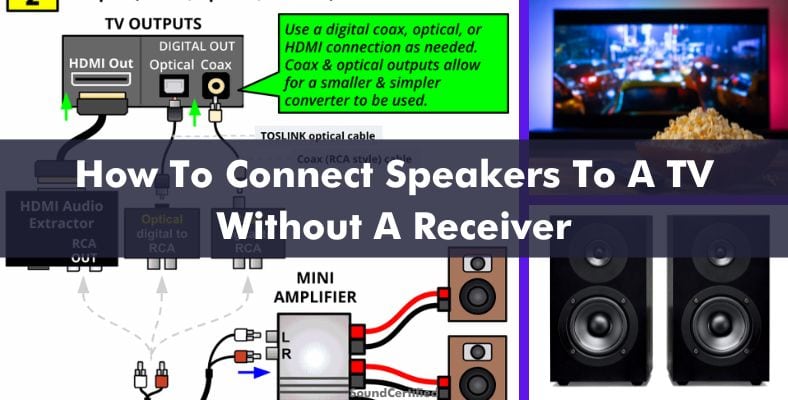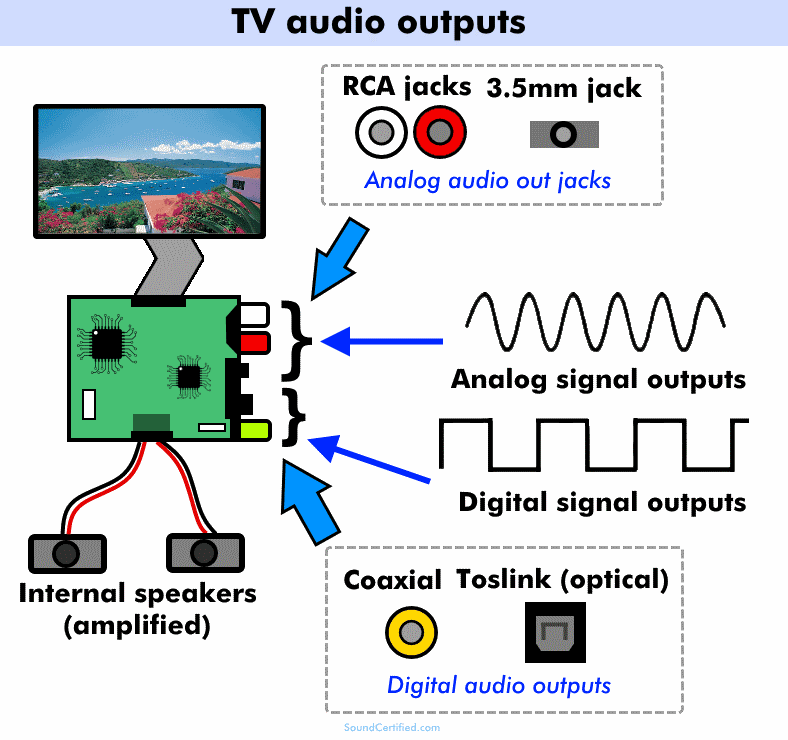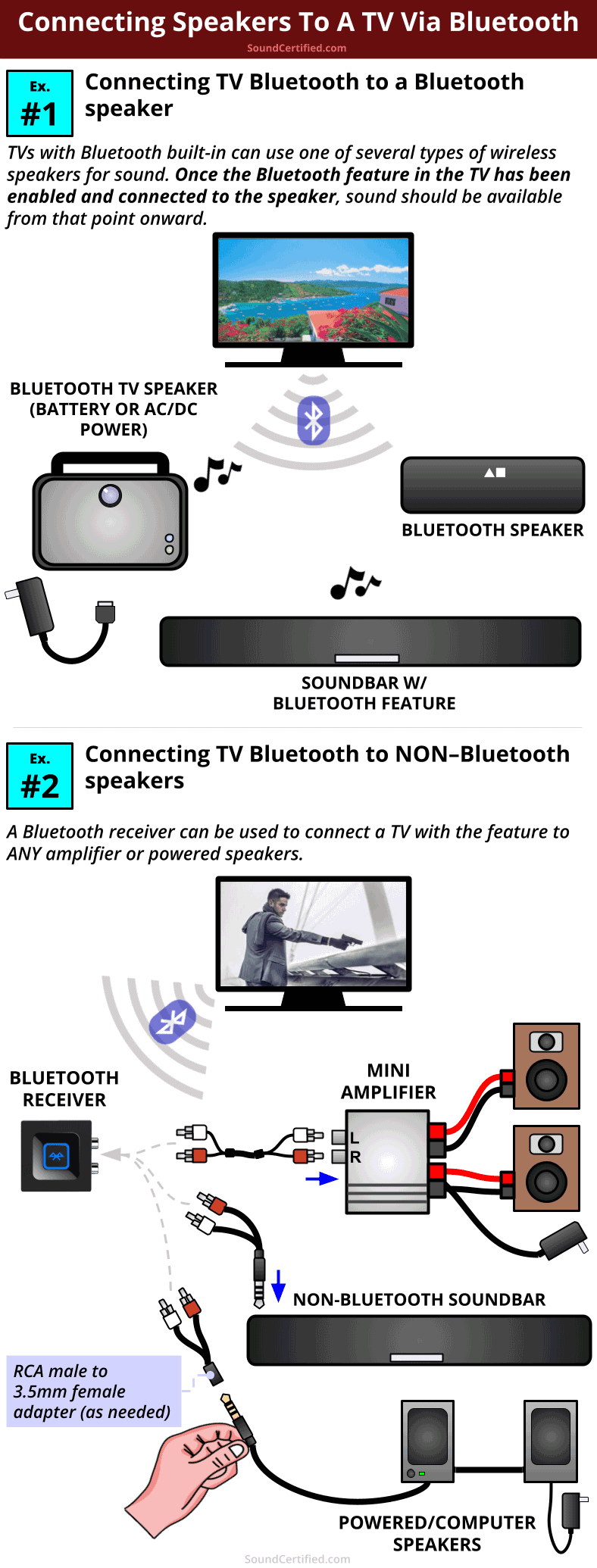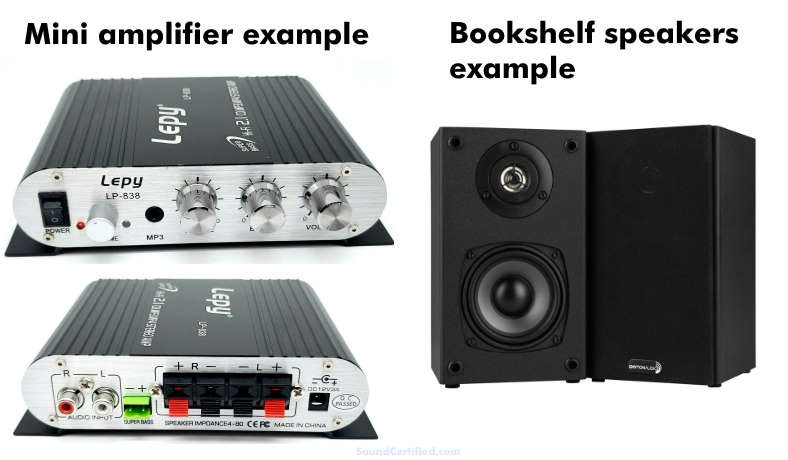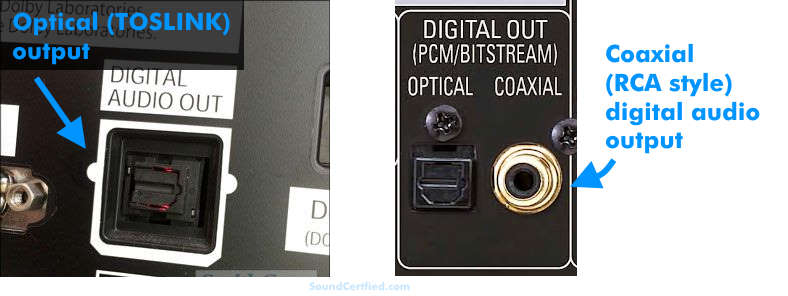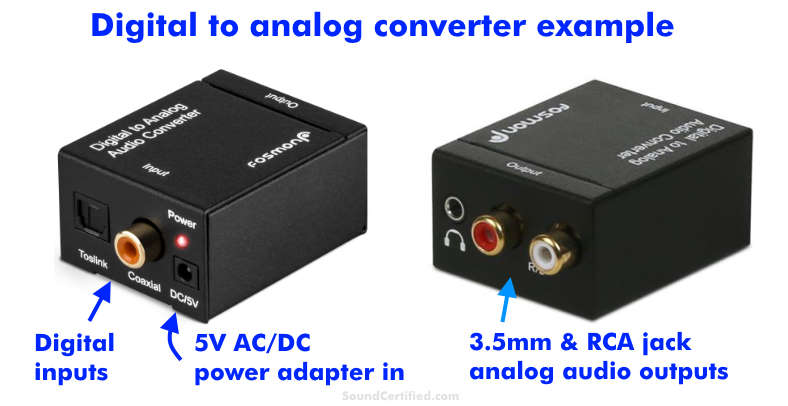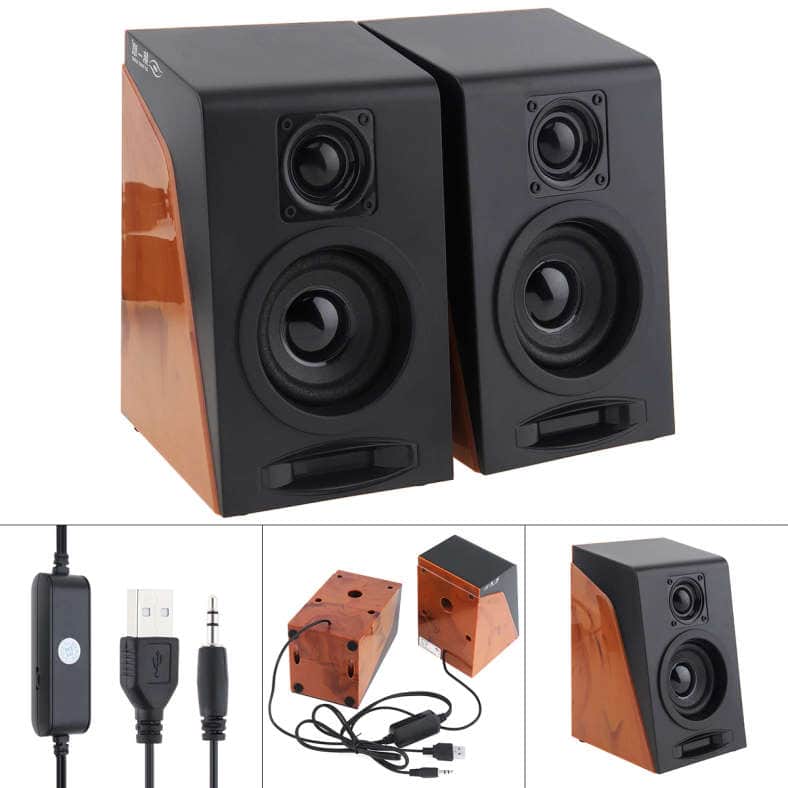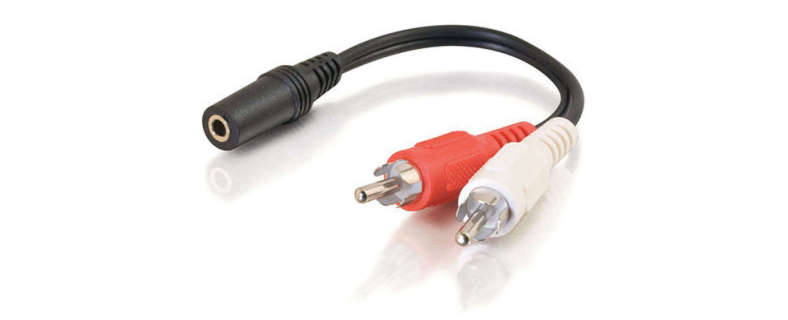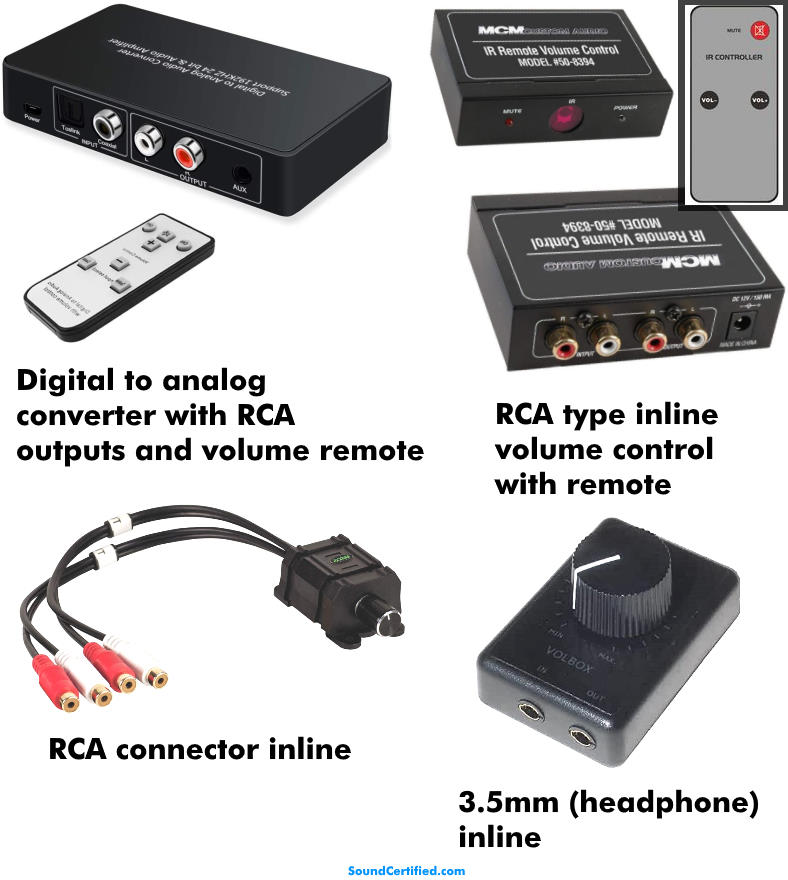Welcome! In this article, I’ll cover:
- How you can connect and use speakers with a TV without a receiver or stereo amplifier.
- Clear and detailed diagrams showing you exactly how to connect everything.
- Additional options to enjoy TV audio without spending a ton.
Contents
Do you need a receiver for TV speakers?
Here are the quick facts to know:
- You do not need an audio video receiver (AV receiver) or stereo system for TV sound. However, for standard speakers, you DO need some type of small amplifier to power them.
- Most TVs do not provide speaker outputs that can drive speakers directly as that requires an amplifier of some sort to power them. However, most TVs do provide audio ports that make it possible to connect them to powered speakers, AV receiver, or mini amplifier to power your speakers.
- The cables and parts you’ll need will depend on your specific TV model and the outputs provided. There’s no standard set of TV audio outputs, although most have one or more of the following: RCA (stereo) jacks, a 3.5mm stereo jack, digital optical/coaxial jacks, or something similar.
- Some modern televisions provide only a single HDMI output jack. In this case, it’s still possible to connect an external set of speakers or amp by using an HDMI audio extractor that provides RCA output jacks, as you’ll see below.
AV receivers are nice to have, but not everyone can afford one or even wants one. It’s fairly simple to enjoy TV sound another what once you know what you do. Read on and I’ll show you how.
How TV audio outputs work + common TV connections
Unfortunately, almost no TVs have built-in speaker outputs. It’s very unusual to find a TV these days that you can simply connect to some bookshelf stereo speakers, for example.
Instead, TVs usually provide analog or digital signal outputs that can be connected to an external amplifier or home stereo receiver. These signals are output from the internal electronics when sent a cable TV, digital media, or other signal that’s decoded and the audio extracted from.
1. Analog audio outputs
Common TV analog outputs are:
- RCA stereo jacks: left & right stereo signal outputs, which can be connected to a home receiver’s AUX input RCA or to powered speakers.
- 3.5mm (1/8″) headphone sized stereo jack: left, right, and ground signal connections
This type can be connected to nearly any audio amplifier, powered speakers, or receiver with RCA or a 3.5mm (1/8″ headphone style) input jack as long as you have the correct connector type.
2. Digital audio outputs
Digital audio outputs must be converted to an analog sound signal either using a converter box or to a home stereo/home theater receiver with digital audio inputs.
Standard digital outputs are the following:
- Optical digital output: This is almost always a TOSLINK type connector that uses a plug-in fiber optic cable you can buy (not expensive).
- Coaxial digital output: Coaxial digital connections carry the same digital signal as optical but use a wired cable nearly identical to a single RCA cable.
- HDMI video + audio: A high-definition multimedia interface (HDMI) carries both video and audio digital signals over a multi-wire, multi-pin cable and connector. It’s possible to use only audio with the right converter, as you’ll see below.
3. Wireless / Bluetooth connectivity
TVs with Bluetooth connectivity use a low-power protocol to send stereo sound over a broadcast. This type of connection has a range of somewhere around 30 feet (9.1 meters) or so depending on the environment and the particular device.
Since Bluetooth is less commonly found in TVs than the other outputs I’ve listed above, I’ll cover it in a separate section later.
DIAGRAM – How to connect speakers to a TV without a receiver

As you can see from my diagram above, there are 3 main ways to connect speakers to a TV and get sound without a receiver:
- Connecting your speakers to a mini amplifier and one of the audio outputs available.
- Using a digital-to-analog converter to get an audio signal from a digital output.
- Using powered speakers or computer speakers to connect directly to an audio output.
(As I mentioned earlier, sometimes it’s possible to use a Bluetooth connection as well. I’ll cover this in a separate section further below.)
1. Connecting a small amplifier to standard analog audio outputs
You might think that you’ll need to spend a ton of money to power a higher-quality pair of “real” speakers like some great 4 1/2″ or 6 1/2″ just like a regular (and much more expensive) home stereo receiver. It’s not the case at all!
If you shop carefully, it’s possible to use a very basic – and affordable – mini amp and external speakers on a budget. For average TV, movie, and music channel listening you’ll only need 5W or more per channel amp power.
Amplifiers of this kind start in price around $20 with 15W per channel and a great-sounding pair of bookshelf speakers can be found for about $26 and up. Like many things, it depends on your needs and your budget.
As shown in the diagram, you’ll need to connect the amplifier to the TV’s audio outputs using RCA cable or in some cases, and 3.5mm adapter also. Most mini amps come with an AC-DC wall power supply you’ll plug in.
Next, you’ll connect the amp to the speaker terminals using speaker wire and you’re ready.
2. Connecting to and converting audio from a digital output
Examples of digital audio output connectors some TVs use.
What if your television only has digital audio outputs? While it is a little bit more complicated, there is a good solution. To use digital audio connections, you’ll need: (1) A stereo receiver with digital audio inputs OR (2) a digital to analog (RCA) converter.
A digital to analog converter is a small box with an AC-DC adapter (supplied with it) and input & output jacks on both ends. They make it possible to derive sound if you only have a digital audio output and connect to any standard amplifier or powered speaker set.
A digital to analog converter allows you to connect a TV without analog outputs (RCA jacks or a 3.5mm audio jack) to any equipment, making them super handy. Most sell for $15-$25 or so, depending on the brand and seller.
The sound quality is very good and they’re easy to connect and use – just leave them powered up and when the TV’s digital audio stream begins it will automatically be converted to a standard analog musical signal you can hear.
3. Directly connecting computer speakers or powered speakers
Shown: An example of self-powered computer speakers with 3.5mm audio connection and USB power connector.
Computer speakers are the easiest way to add speakers to your TV. Most have a small audio amplifier built in and provide an AC-DC adapter or a 5V USB power connection. If your TV doesn’t have a USB power port (most don’t) you can simply use a USB phone charger.
These speaker types can give great sound quality if you shop carefully and are affordable, too. A decent pair start close to $15 and above, while there are cheaper products out there. However, the cheaper models tend to have a very “thin” sound: poor treble, poor bass, and overall a very bland sound response.
More advanced speaker sets include a self-powered subwoofer for even better bass response. Since PC speakers use small speaker cones many can’t produce much bass.
How to connect computer speakers to a TV without a headphone size jack
Most PC speaker sets use a standard 1/8″ (3.5mm) stereo headphone connector, so for TVs without a 3.5mm jack you may need an RCA to 3.5mm adapter cable.
They’re usually about $3 or less and available at many online retailers and sometimes your local retail audio/video store, too.
DIAGRAM – Connecting speakers to a TV via Bluetooth
I’ve left this section a separate one because it’s a far less common option, unfortunately, as some but not a lot of TVs offer a Bluetooth connection feature. It’s more commonly found on smart TVs but is not guaranteed to be available.
However, if yours has Bluetooth available, it’s relatively easy to connect a TV to speakers and get sound:
- Connecting your TV to one of several Bluetooth wireless speaker types: a soundbar, Bluetooth portable speakers, or wireless TV speakers.
- Using a Bluetooth receiver and then connecting the audio outputs to a stereo system, amplifier, or powered speakers.
Both are relatively simple to do, although Bluetooth is often disabled by default on a TV so you’ll need to enable it in the settings. After that, wireless devices can be connected and used from that point forward. In both cases, the sound quality should be very good, although be aware that the end sound quality will greatly depend on the speakers themselves.
Soundbars are an excellent option for people who want nice sound in a compact space. However, not all soundbars feature a receiver built in so it’s important to always check when shopping.
Many can use different audio sources so a wireless receiver can allow you to still use an existing soundbar you may already have.
What if your TV’s audio out volume can’t be changed?
Shown here are several ready-made solutions for TVs that don’t control their audio output jack volume via the remote.
There’s one headache you may run into but aren’t aware of: not all TVs allow you to adjust the output volume with your remote when using the output jacks. Unfortunately, it’s basically something you won’t find out until you try as TV manufacturers often don’t mention it in the owner’s manual or other information.
Several of my readers discovered this problem and needed a way to adjust the sound output of their TV.
The good news is that there are some solutions to this problem:
- TVs with a digital output: you can use a digital to analog (RCA) converter with remote and adjustable volume output. These cost around $20 USD.
- TVs with only a 3.5mm headphone type or RCA type jacks: you can use a device like the MCM #50-8394 inline volume control with remote, although it’s not as cheap (about $44 USD).
- If you’re on a tight budget or don’t care about a remote control, you can also use inline RCA volume control with knob. You’ll just need connecting cables of sufficient length.
- You can use a 3.5mm headphone type connector with inline volume control with an adjustable knob to control the sound level.
I recommend using a digital audio output and a converter box with a remote if possible. It does require you to buy that type of converter with a remote but it makes it much less of a hassle. If that’s not an option, RCA inline volume controls work well and are easy to use too.
